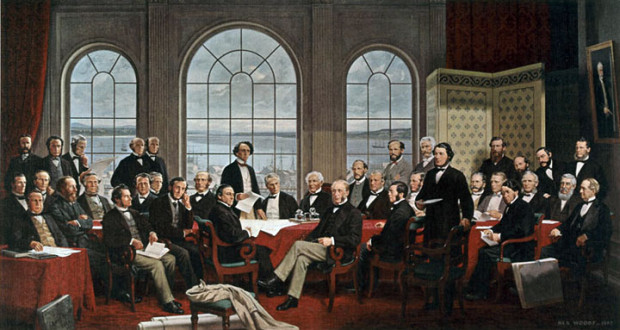Is the Liberal plan to reform the electoral system unconstitutional? Two recent pieces published in the Globe and Mail and Toronto Star suggest the answer is yes. The articles are well-written by knowledgeable individuals (respectively, a law professor and two former law clerks), but in my view their reasoning is flawed.
Both pieces cite the 2014 Senate Reform Reference, in which the Supreme Court held that Parliament could not impose consultative elections or term limits of senators as this would require a constitutional amendment and the consent of at least seven provinces representing at least fifty-percent of the population. The Senate Reform Reference has faced a good deal of criticism for reading in constitutional requirements that are not evident from the text itself. But even accepting the correctness of the decision, it is clearly distinguishable from the issue at hand.
To make the case that electoral reform is unconstitutional, one must demonstrate 1) that reform would require a constitutional amendment; 2) that Parliament would be incapable of passing this amendment unilaterally under s.44 of the Constitution Act, 1982, which grants Parliament the authority to amend the Constitution “in relation to…the House of Commons.”
With respect to the first hurdle, much depends on the particulars of the proposal. A system of proportional representation would almost certainly offend the Constitution and require an amendment since Canada would no longer be divided into “electoral districts” (ridings) with each district electing “One Member,” as currently mandated by the Constitution. On the other hand, a ranked voting system – which is what the Liberals seem to be leaning toward – would not run afoul of the Constitution since “One Member” would still be elected from each district.
It should also be remembered that the Supreme Court in the Senate Reform Reference relied heavily on the original intent of the Fathers of Confederation to support the conclusion that an unelected Senate formed an integral part of Canada’s “constitutional architecture.” The issue of whether senators should be elected or appointed was discussed and debated at length following the Quebec Conference in 1864, and there can be little doubt that many of the Fathers – and certainly the more prominent among them – favoured an unelected upper chamber that would be insulated from populist pressures; in short, a body of “sober second thought.” By contrast, it is not at all clear that the Fathers ever expressly considered the method of electing House Members. The first-past-the-post (“FPTP”) system appears to have been adopted almost by default, simply as a matter of convention.
In sum, neither the text of the Constitution nor the intent of the Fathers supports the proposition that FPTP is constitutionally entrenched.
Even if the proposed reform would require an amendment, as in the case of proportional representation, Parliament could likely pass it unilaterally. The test, according to the Senate Reform Reference, is whether the proposed amendment engages provincial interests by changing the “fundamental nature or role” of the House. It is a stretch to argue that replacing FPTP would meet this threshold. Democratic elections using ranked ballots or proportional representation are still democratic elections, and implementing either system would not transform the “fundamental nature or role” of the House of Commons.
Despite venturing into some murky interpretive waters, the Senate Reform Reference did not utterly lose sight of the constitutional text. The Court held that the words of the Constitution provide “guides” to what is “protected content.” Section 42 of the Constitution Act, 1982, which describes the type of amendments that require provincial consent, expressly lists the “method of selecting senators.” There is no equivalent provision that, even on a liberal reading, could refer to the method of electing House Members.
To be sure, section 42(1)(e) of the Act states that amendments regarding the “proportionate representation of the provinces” in the House do require provincial consent; but this is almost certainly a non-issue since the Liberals would be foolish to impose a plan that would alter the representation of the provinces. In fact, this subsection provides further evidence that Parliament could pass a reform amendment unilaterally. The framers of the Constitution Act, 1982 were clearly desirous of protecting provincial interests. That they would see fit to safeguard the proportionate representation of the provinces, but say nothing about the method of elections generally, strongly suggests that they did not consider the latter to engage provincial interests.
The issue of electoral reform has never been directly before the Supreme Court of Canada, but it is noteworthy that in a 2003 decision, Figueroa v. Canada, three justices discussed the issue in a concurring opinion. After extolling the virtues of FPTP, the justices rejected the proposition that “FPTP…is constitutionally mandated.” On the contrary, “the government has a fairly wide latitude in choosing how to design the electoral system …” These words were admittedly obiter dicta and would not bind a future panel. Nevertheless, they would certainly add weight to the government’s position should the issue ever come before the Court.
None of this is to say that electoral reform is a good thing. As I have previously argued, proportional representation in particular would be problematic in the Canadian context. There is surely something offensive about the government of the day unilaterally changing an electoral system that has been in place continuously for a century and a half and has stood the test of time. This is one issue where a national referendum would be appropriate, or, at the very least, a free vote in Parliament that requires a super-majority to pass. But these are philosophical objections. From a legal perspective, the only thing standing in the way of reform is the Senate, which would have to approve the plan, constitutional amendment or not. Perhaps this is one instance where the legislative process would benefit from some sober second thought.
 Advocates for the Rule of Law
Advocates for the Rule of Law



